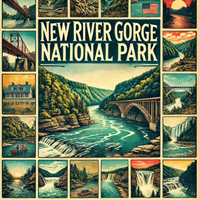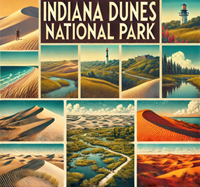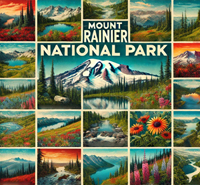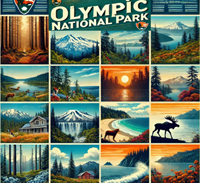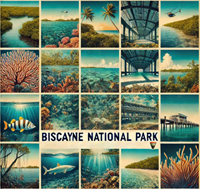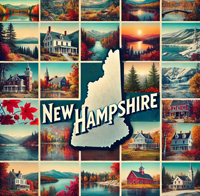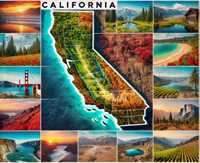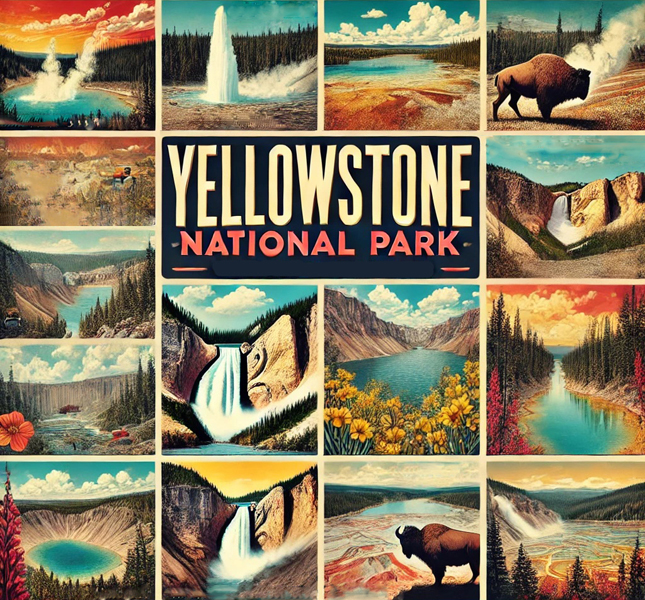
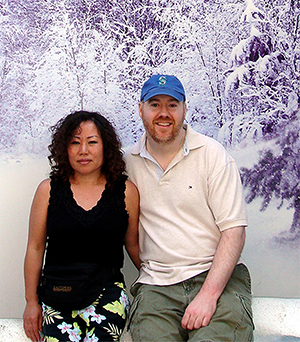
William and Hui Cha Stanek have meticulously crafted these national park guides, each showcasing the most stunning landscapes across the USA. But beyond the breathtaking scenery, these guides delve into the stories, experiences, and connections that make each park visit truly memorable.
National Parks Index | US Itineraries Index | American Roadtrips Index
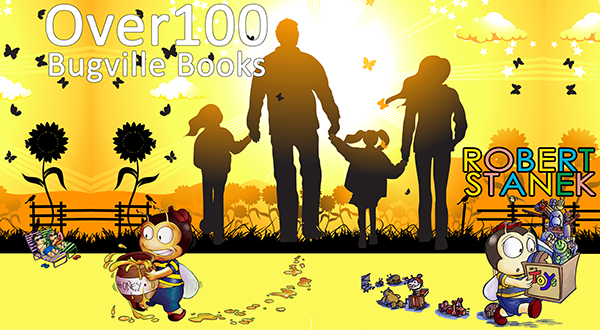
Bring home a Bugville Critters book and watch as your child's love for reading and learning grows with every page. Hand-painted illustrations bring the heartwarming stories to life. Ask your librarian to add Bugville Critters to the library's digital collection today!
Discover William Stanek's Exclusive Art Collection
Explore and purchase the stunning art featured on this site. Own a piece of William Stanek's unique and captivating artwork today!
(May 2, 2025) Introducing Yellowstone National Park: America's First National Park
Introduction to Yellowstone National Park
Yellowstone was one of the first national parks I ever visited, and it set the stage for my lifelong love affair with America's wild spaces. The sheer diversity of the landscape-- from geysers and hot springs to deep forests and expansive meadows-- left me in awe. One particular memory that stands out is watching Old Faithful erupt, a timeless ritual that never fails to impress. But it' s not just the famous sights that make Yellowstone special; it' s the unexpected encounters with wildlife, like the time we came across a herd of bison grazing peacefully near the road. Yellowstone is a place that keeps you on your toes, always ready to surprise you with something extraordinary.
How to Reach Yellowstone National Park
From the North (Bozeman, MT): Travelers from Bozeman can take Interstate 90 east to US Highway 89 south, which leads directly to the North Entrance of Yellowstone at Gardiner, Montana. The drive is approximately 90 miles and takes about 1.5 hours.
From the South (Jackson, WY): From Jackson, take US Highway 191/89 north through Grand Teton National Park and continue into Yellowstone. The distance to the South Entrance is about 60 miles, taking around 1.5 hours.
From the East (Cody, WY): Visitors from Cody can take US Highway 14/16/20 west directly to the East Entrance of Yellowstone. The drive covers about 50 miles and takes approximately 1 hour, passing through the scenic Shoshone National Forest.
From the West (Idaho Falls, ID): Travelers from Idaho Falls can take US Highway 20 north to the West Entrance at West Yellowstone, Montana. The distance is about 110 miles, taking around 2 hours.
Exploring Yellowstone: Must-Visit Sites
Old Faithful: The most famous geyser in the park, known for its predictability and frequent eruptions. The nearby Old Faithful Inn is also a historic landmark.
Grand Prismatic Spring: The largest hot spring in the United States, renowned for its vibrant colors and expansive size.
Yellowstone Lake: The largest high-elevation lake in North America, offering boating, fishing, and stunning views.
Grand Canyon of the Yellowstone: Featuring spectacular waterfalls and colorful canyon walls, this site offers several viewpoints and hiking trails.
Mammoth Hot Springs: Known for its terraced formations created by the deposition of calcium carbonate from hot springs.
Seasonal Variations
Spring: Warming temperatures and melting snow create beautiful waterfalls and lush meadows. Wildlife is abundant, as many animals give birth to their young. Some higher elevation areas may still be snow-covered.
Summer: The most popular season, with warm weather and fully accessible roads and trails. Expect crowds at popular sites, but also enjoy a wide range of activities and ranger-led programs.
Fall: Cooler temperatures and fewer visitors make autumn a pleasant time to explore the park. Fall foliage adds vibrant colors to the landscape, and wildlife is active as animals prepare for winter.
Winter: Snow blankets the park, offering a unique and serene experience. Activities include snowshoeing, cross-country skiing, and snowmobile tours. Some roads and facilities are closed during the winter months.
Visitor Updates for Yellowstone National Park
Conservation Efforts
William Stanek's dedication to conservation is showcased through his work at Yellowstone National Park, where he advocates for the protection of its geothermal features, wildlife, and ecosystems. By capturing the park's beauty through his photography and engaging in conservation initiatives, William aims to highlight the importance of preserving this iconic national treasure for future generations.
1 Day at Yellowstone National Park: Discovering Nature's Masterpiece
Introduction
Spending a day at Yellowstone National Park allows you to immerse yourself in a landscape filled with geothermal wonders, abundant wildlife, and majestic scenery. Here's a detailed guide to making the most of your visit, with expert tips from William and Hui Cha Stanek.
Morning: Sunrise and Geothermal Wonders
6:00 AM - Sunrise at Artist Point
Overview: Start your day with the breathtaking sunrise from Artist Point, offering stunning views of the Grand Canyon of the Yellowstone and the Lower Falls. Tips from William: Arrive at least 30 minutes before sunrise to secure a good spot. Bring a tripod and wide-angle lens to capture the expansive views of the canyon and waterfall illuminated by the early morning light. Insights from Hui Cha: Dress warmly, as it can be chilly in the early morning. Bring a thermos of hot coffee or tea to enjoy while waiting for the sunrise.
7:00 AM - Breakfast at the Lake Hotel
Overview: Head to the historic Lake Hotel for a hearty breakfast with beautiful views of Yellowstone Lake. Tips from William: Try the local specialties, and use this time to plan your day. The early morning light on the lake provides excellent photo opportunities. Insights from Hui Cha: The hotel's ambiance is charming and historical, making it a pleasant start to your day.
Mid-Morning: Exploring the Geyser Basins
8:30 AM - Old Faithful and Upper Geyser Basin
Overview: Drive to the Upper Geyser Basin, home to Old Faithful and many other geysers and hot springs. Tips from William: Check the predicted eruption times for Old Faithful at the visitor center and plan to arrive at least 20 minutes early to find a good viewing spot. Use a fast shutter speed to capture the eruption's details. Insights from Hui Cha: After watching Old Faithful, take a walk around the boardwalks of the Upper Geyser Basin to explore other geysers and thermal features.
10:30 AM - Midway Geyser Basin and Grand Prismatic Spring
Overview: Visit Midway Geyser Basin to see the iconic Grand Prismatic Spring, the largest hot spring in the United States. Tips from William: For the best photos, hike the short trail to the Grand Prismatic Spring Overlook on the Fairy Falls Trail. A wide-angle lens and a polarizing filter will help capture the vibrant colors. Insights from Hui Cha: The boardwalk around the Midway Geyser Basin offers close-up views of other thermal features. Be prepared for strong sulfur smells and stay on designated paths.
Late Morning: Wildlife Viewing
11:30 AM - Hayden Valley
Overview: Drive to Hayden Valley, one of the best places in the park to view wildlife such as bison, elk, and possibly grizzly bears. Tips from William: Bring a telephoto lens to capture wildlife from a safe distance. Early mornings and late evenings are the best times for wildlife sightings. Insights from Hui Cha: Patience is key when wildlife watching. Bring binoculars and be respectful of the animals' space.
Afternoon: Scenic Drives and Iconic Spots
12:30 PM - Picnic Lunch at Yellowstone Lake
Overview: Enjoy a packed lunch at one of the picnic areas around Yellowstone Lake, the largest high-elevation lake in North America. Tips from William: Use a lightweight, portable camera for capturing candid moments during your lunch break. The lake's serene setting provides a beautiful backdrop for photos. Insights from Hui Cha: Pack a nutritious and energizing meal. Stay hydrated, especially if you plan to hike later in the day.
1:30 PM - Norris Geyser Basin
Overview: Explore the Norris Geyser Basin, the hottest and most dynamic geyser basin in Yellowstone. Tips from William: Capture the dramatic landscapes of Porcelain Basin and the various geysers and hot springs. Use a wide-angle lens for landscape shots and a macro lens for details. Insights from Hui Cha: The trails here can be quite hot, so bring water and wear a hat. The geothermal activity in this area is fascinating but be mindful of the fragile environment.
Late Afternoon: Canyon and Waterfalls
3:00 PM - Grand Canyon of the Yellowstone
Overview: Head back to the Grand Canyon of the Yellowstone to explore more viewpoints such as Lookout Point, Inspiration Point, and Lower Falls. Tips from William: The late afternoon light is perfect for photographing the canyon and waterfalls. Use a polarizing filter to enhance colors and reduce glare. Insights from Hui Cha: Take your time to enjoy the different perspectives of the canyon. Each viewpoint offers unique photo opportunities.
4:30 PM - Upper Falls
Overview: Visit the Upper Falls of the Yellowstone River, located upstream from the Lower Falls. Tips from William: Capture the power of the falls with a tripod and long exposure settings to create a silky effect with the water. Use a wide-angle lens for full views. Insights from Hui Cha: The area can be misty from the falls, so protect your camera equipment and be prepared for slippery surfaces.
Evening: Sunset and Dinner
6:00 PM - Dinner at Mammoth Hot Springs Hotel
Overview: Drive to the Mammoth Hot Springs area and enjoy dinner at the historic Mammoth Hot Springs Hotel. Tips from William: The terrace formations of Mammoth Hot Springs are a must-see, so plan to explore them before or after dinner. Capture the unique terraces with a wide-angle lens. Insights from Hui Cha: The hotel's dining options are excellent, and the surrounding area is rich in history and wildlife.
7:30 PM - Sunset at Mammoth Hot Springs Terraces
Overview: End your day with a stunning sunset at the Mammoth Hot Springs Terraces. Tips from William: Use a tripod for steady shots and capture the vibrant colors of the sunset reflecting off the terraces. Experiment with different compositions and angles. Insights from Hui Cha: Bring a blanket or chair to sit and enjoy the sunset. The terraces' otherworldly landscape is a perfect way to conclude your day in Yellowstone.
Conclusion
Spending a day at Yellowstone National Park offers a whirlwind tour of its most iconic sights and experiences. From geysers and hot springs to wildlife and breathtaking landscapes, every moment is filled with wonder. With expert tips from William and insights from Hui Cha Stanek, you're equipped to capture stunning photographs and make the most of your visit to this incredible national park.
Yellowstone National Park
Park History and Cultural Significance
Yellowstone National Park, established on March 1, 1872, is the world's first national park. It covers over 2.2 million acres and is renowned for its geothermal features, including the iconic Old Faithful geyser, colorful hot springs, and bubbling mud pots. The park's history is deeply intertwined with Native American tribes who have inhabited the area for thousands of years. Tribes such as the Shoshone, Crow, and Blackfeet consider the region sacred and have rich cultural stories connected to the park's natural features. The establishment of Yellowstone marked a significant step in conservation history, setting a precedent for the protection of natural landscapes worldwide .
Visitor Centers and Facilities
Yellowstone National Park offers several visitor centers and facilities to enhance the visitor experience:
- Old Faithful Visitor Education Center: Located near the famous geyser, this center provides exhibits on geothermal features and ranger-led programs.
- Canyon Visitor Education Center: Focuses on the geological history of the Yellowstone Canyon and its unique landscape.
- Mammoth Hot Springs Visitor Center: Offers insights into the park's history and ecology.
- West Yellowstone Visitor Information Center: Located just outside the park, it provides information and resources for planning visits.
These centers offer educational exhibits, park information, maps, and restrooms, ensuring visitors have access to essential services and knowledge about the park's natural and cultural heritage .
Best Times to Visit
Yellowstone can be visited year-round, but the best time to visit depends on your interests:
- Spring (April to June): Ideal for wildlife viewing as animals emerge from hibernation and newborns are visible. However, some roads and facilities may still be closed due to snow.
- Summer (July to August): The most popular time to visit, with all roads and facilities open. Perfect for hiking, camping, and exploring geothermal features. However, expect large crowds and higher accommodation prices.
- Fall (September to October): Offers a quieter experience with fewer crowds. The weather is cooler, and the fall foliage is stunning. Wildlife is active, preparing for winter.
- Winter (November to March): A unique time to visit for snowshoeing, cross-country skiing, and enjoying the serene, snowy landscape. Limited access as many roads are closed; snowmobile and snowcoach tours are available .
Activities and Recreation
Yellowstone provides a wide range of activities for visitors:
- Hiking: Over 900 miles of trails, from easy walks to challenging backcountry routes.
- Wildlife Viewing: Opportunities to see bison, elk, grizzly bears, wolves, and more.
- Geothermal Features: Visiting geysers, hot springs, and mud pots.
- Fishing: World-renowned fly fishing in the park's rivers and lakes.
- Camping: 12 campgrounds with over 2,000 sites.
- Boating: Allowed on Yellowstone Lake and Lewis Lake.
- Winter Sports: Snowshoeing, cross-country skiing, and guided snowmobile tours .
Accessibility Information
Yellowstone National Park strives to be accessible to all visitors:
- Visitor Centers: Equipped with ramps, accessible restrooms, and exhibits.
- Trails: Some accessible trails include the boardwalks around Old Faithful, Mammoth Hot Springs, and the West Thumb Geyser Basin.
- Camping: Accessible campsites available at several campgrounds.
- Ranger Programs: Many programs are accessible, with assistive listening devices available.
- Transportation: Accessible shuttle services are available, and some park roads are wheelchair-friendly .
Permits and Regulations
- Entrance Fees: Required for all visitors, with options for single visits, annual passes, and interagency passes.
- Backcountry Permits: Required for overnight backcountry trips.
- Fishing Permits: Mandatory for fishing within the park.
- Wildlife Viewing: Maintain a safe distance from wildlife; at least 100 yards from bears and wolves, and 25 yards from other animals.
- Leave No Trace: Follow principles to protect the natural environment, including packing out all trash and minimizing impact on trails and campsites .
Yellowstone National Park offers a rich blend of natural beauty, cultural history, and diverse recreational opportunities, making it a must-visit destination for nature enthusiasts and history buffs alike.
Nearby: Grand Teton National Park, Shoshone National Forest
-
Grand Teton National Park: About an hour from Yellowstone, Grand Teton is known for its stunning mountain scenery and outdoor activities.
- Activities: Hiking, camping, wildlife viewing.
- Notable Sites: Jenny Lake, Snake River Overlook.
- Wildlife: Grizzly bears, moose, elk.
-
Shoshone National Forest: Adjacent to Yellowstone, this forest offers diverse landscapes, including mountains, forests, and rivers.
- Activities: Hiking, fishing, camping, wildlife viewing.
- Notable Trails: Wind River Range, Beartooth Mountains.
- Wildlife: Grizzly bears, bighorn sheep, various bird species.
Important Updates for Yellowstone National Park
Yellowstone National Park (Wyoming, Montana, Idaho)
Yellowstone National Park, established in 1872 as the world's first national park, spans across Wyoming, Montana, and Idaho. It is celebrated for its geothermal wonders, including geysers, hot springs, and mud pots, as well as its diverse landscapes of lush forests, expansive meadows, and abundant wildlife. The park's iconic features include Old Faithful, Grand Prismatic Spring, and the Grand Canyon of the Yellowstone. Renowned photographers William and Hui Cha Stanek have masterfully captured Yellowstone's awe-inspiring beauty through their lenses. This guide explores local attractions, nearby towns and cities, scenic drives, and the best hikes in and around Yellowstone National Park, enriched by the Staneks' expertise and experiences.
The gateway town of West Yellowstone, located near the park's West Entrance, offers a variety of amenities including lodging, dining, and shops. It is also home to attractions such as the Grizzly and Wolf Discovery Center and the Yellowstone Historic Center. Gardiner, near the North Entrance, provides additional amenities and activities, such as whitewater rafting and the historic Roosevelt Arch.
For those traveling from the east, Cody, Wyoming, provides a rich array of accommodations, dining options, and attractions like the Buffalo Bill Center of the West, the Cody Nite Rodeo, and Old Trail Town. The towns of Jackson, Wyoming, and Bozeman, Montana, offer extensive amenities, including hotels, restaurants, shopping, and cultural attractions, making them excellent bases for exploring Yellowstone and the surrounding regions.
For visitors seeking to extend their adventures, nearby Grand Teton National Park and the Shoshone National Forest offer additional opportunities for hiking, wildlife viewing, and experiencing the stunning natural beauty of the greater Yellowstone ecosystem.
Yellowstone's backcountry is vast and remote. Be prepared for encounters with wildlife, variable weather, and difficult terrain.
- Wildlife: Bears are common. Carry bear spray and know how to use it. Follow all food storage regulations to avoid attracting bears.
- Thermal Areas: Stay on marked trails in geothermal areas. The ground can be unstable and dangerous.
- Permits: Required for overnight backcountry trips.
Local Attractions and Surrounding Areas
Yellowstone National Park is surrounded by numerous attractions that enhance the visitor experience. Here are some must-see local attractions:
- Old Faithful: The most famous geyser in the park, known for its predictable eruptions every 60 to 110 minutes.
- Grand Prismatic Spring: The largest hot spring in the United States, renowned for its vibrant colors and size.
- Mammoth Hot Springs: A complex of hot springs on a hill of travertine, with dramatic terraces.
- Yellowstone Lake: One of the largest high-elevation lakes in North America, offering boating and fishing opportunities.
- Grand Canyon of the Yellowstone: A stunning canyon with two major waterfalls, the Upper and Lower Falls.
- Norris Geyser Basin: The hottest and most dynamic geyser basin in the park, featuring a variety of geothermal features.
- Lamar Valley: Known as the "Serengeti of North America," this valley is ideal for wildlife viewing, particularly for bison, wolves, and bears.
Nearby Towns and Cities
Visitors to Yellowstone National Park can find additional amenities and activities in nearby towns and cities:
- West Yellowstone, Montana: Located near the park's West Entrance, West Yellowstone offers accommodations, dining, shopping, and attractions such as the Grizzly and Wolf Discovery Center and the Yellowstone Historic Center.
- Gardiner, Montana: Located near the park's North Entrance, Gardiner provides lodging, dining, and activities such as whitewater rafting and the historic Roosevelt Arch.
- Cody, Wyoming: Located east of the park, Cody offers accommodations, dining, shopping, and attractions such as the Buffalo Bill Center of the West, the Cody Nite Rodeo, and Old Trail Town.
- Jackson, Wyoming: Located south of the park, Jackson offers extensive amenities, including hotels, restaurants, shopping, and attractions such as the National Elk Refuge, Jackson Hole Mountain Resort, and the National Museum of Wildlife Art.
- Bozeman, Montana: Located north of the park, Bozeman offers a wide range of amenities, including hotels, restaurants, shopping, and attractions such as the Museum of the Rockies and the Bozeman Hot Springs.
Scenic Drives
Yellowstone National Park offers several scenic drives that provide beautiful views of the park's landscapes and access to its geothermal features. These drives are perfect for capturing the essence of the park through photography.
-
Grand Loop Road:
- Details: This 142-mile loop road connects all major attractions in the park, including Old Faithful, Grand Prismatic Spring, and the Grand Canyon of the Yellowstone.
- Key Stops: Highlights include Old Faithful, Grand Prismatic Spring, Mammoth Hot Springs, Norris Geyser Basin, Yellowstone Lake, and the Grand Canyon of the Yellowstone.
- Photography Tips: William Stanek suggests stopping at the various viewpoints and pull-offs to capture the park's diverse landscapes and geothermal features. Early morning and late afternoon provide the best lighting for photography.
-
Firehole Lake Drive:
- Details: This 3-mile one-way drive off the Grand Loop Road offers access to several geothermal features, including Great Fountain Geyser, White Dome Geyser, and Firehole Lake.
- Key Stops: Highlights include the Great Fountain Geyser, White Dome Geyser, and Firehole Lake.
- Photography Tips: Hui Cha Stanek recommends using a wide-angle lens to capture the geothermal features and a polarizing filter to enhance colors. The best times for photography are during the golden hours of sunrise and sunset.
-
Dunraven Pass:
- Details: This scenic section of the Grand Loop Road runs between Tower Junction and Canyon Village, offering stunning views of Mount Washburn and the surrounding landscape.
- Key Stops: Highlights include the Mount Washburn Trailhead and various overlooks with views of the surrounding mountains and valleys.
- Photography Tips: The Staneks suggest using a wide-angle lens to capture the expansive mountain views and a telephoto lens for wildlife. Early morning and late afternoon provide the best light for photography.
-
Lamar Valley Road:
- Details: This section of the Northeast Entrance Road runs through Lamar Valley, offering excellent opportunities for wildlife viewing.
- Key Stops: Highlights include various pull-offs and viewpoints for wildlife observation.
- Photography Tips: William Stanek recommends using a telephoto lens for capturing wildlife and a wide-angle lens for the landscape views. Early morning and late afternoon provide the best light for photography.
-
West Thumb Geyser Basin Drive:
- Details: This short drive off the Grand Loop Road provides access to the West Thumb Geyser Basin, located on the shores of Yellowstone Lake.
- Key Stops: Highlights include the Abyss Pool, Fishing Cone, and views of Yellowstone Lake.
- Photography Tips: Hui Cha Stanek suggests using a wide-angle lens to capture the geothermal features and the lake views and a polarizing filter to enhance colors. Early morning and late afternoon provide the best light for photography.
Other Scenic Drives
-
Beartooth Highway (U.S. Route 212): This scenic drive starts near Red Lodge, Montana, and ends at the Northeast Entrance of Yellowstone. It traverses the Absaroka-Beartooth Wilderness and reaches heights of nearly 11,000 feet, offering panoramic views of alpine landscapes.
-
Chief Joseph Scenic Byway (Wyoming Highway 296): Connecting Cody, Wyoming, to the Northeast Entrance of Yellowstone, this byway offers stunning views of the Absaroka Mountains and the Clarks Fork of the Yellowstone River.
Reservations and Timed Entry Information
Click the link to see updates. Wait up to 30 seconds for results.
Best Hikes
Yellowstone National Park offers a variety of hiking trails that cater to all skill levels. Each trail provides unique opportunities for exploration and photography. Here are some of the best hikes in the park for prepared hikers:
-
Mount Washburn Trail:
- Details: This 6-mile round-trip trail offers a moderately strenuous hike to the summit of Mount Washburn, providing panoramic views of the park.
- Key Viewpoints: Highlights include views of the Grand Canyon of the Yellowstone, Hayden Valley, and the Absaroka Range.
- Photography Tips: William Stanek recommends visiting early in the morning or late afternoon to capture the best light. A wide-angle lens is ideal for capturing the expansive views from the summit.
-
Fairy Falls Trail:
- Details: This 5-mile round-trip trail offers an easy hike to Fairy Falls, one of the park's tallest waterfalls, with an optional side trip to the Grand Prismatic Spring Overlook.
- Key Viewpoints: Highlights include views of Fairy Falls and the Grand Prismatic Spring from the overlook.
- Photography Tips: Hui Cha Stanek suggests using a wide-angle lens to capture the waterfall and the vibrant colors of the Grand Prismatic Spring. Early morning and late afternoon provide the best light for photography.
-
Lamar Valley Trail:
- Details: This trail offers various lengths and routes through Lamar Valley, known for its abundant wildlife and stunning landscapes.
- Key Viewpoints: Highlights include opportunities to see bison, wolves, elk, and other wildlife in their natural habitat.
- Photography Tips: William Stanek suggests using a telephoto lens for capturing wildlife and a wide-angle lens for the landscape views. Early morning and late afternoon provide the best light for photography.
-
Artist Point Trail:
- Details: This short trail leads to one of the most famous viewpoints in the park, offering stunning views of the Grand Canyon of the Yellowstone and the Lower Falls.
- Key Viewpoints: Highlights include views of the Lower Falls and the colorful canyon walls.
- Photography Tips: Hui Cha Stanek recommends using a wide-angle lens to capture the expansive canyon views and a polarizing filter to enhance colors. Early morning and late afternoon provide the best light for photography.
-
Mystic Falls Trail:
- Details: This 2.4-mile round-trip trail offers a moderately easy hike to Mystic Falls, a picturesque waterfall in the Biscuit Basin area.
- Key Viewpoints: Highlights include views of Mystic Falls and the surrounding forest.
- Photography Tips: The Staneks suggest using a wide-angle lens to capture the waterfall and a tripod for long exposure shots. Early morning and late afternoon provide the best light for photography.
-
Slough Creek Trail:
- Details: This 20-mile round-trip trail offers a challenging hike through scenic meadows and along Slough Creek, with opportunities for wildlife viewing and backcountry camping.
- Key Viewpoints: Highlights include views of Slough Creek, the meadows, and potential wildlife sightings.
- Photography Tips: William Stanek recommends using a telephoto lens for capturing wildlife and a wide-angle lens for the landscape views. Early morning and late afternoon provide the best light for photography.
Other Hikes
-
Norris Geyser Basin Trails:
- Length: Various loop trails totaling around 2 miles.
- Description: Norris Geyser Basin features several interconnected trails that explore one of the hottest and most dynamic geothermal areas in Yellowstone. Key points of interest include Steamboat Geyser and the Porcelain Basin. William suggests these trails for their unique geothermal features and educational value.
-
Elephant Back Mountain Trail:
- Length: 3.6 miles round trip.
- Description: This moderately difficult hike offers stunning views of Yellowstone Lake from the summit of Elephant Back Mountain. The trail features steep climbs through dense forest, leading to a panoramic viewpoint. William recommends this hike for its scenic beauty and the rewarding views at the top.
William and Hui Cha Stanek's extensive body of work at Yellowstone National Park showcases their deep appreciation for its geothermal wonders, stunning landscapes, and rich biodiversity. William's technical expertise with photographic equipment and Hui Cha's creative vision result in compelling images that highlight the park's unique features and diverse ecosystems. Their dedication often involves waiting for hours to capture the perfect light and conditions, revealing the park's essence in each shot.
Conservation is a core theme in their photography. Through their stunning visual storytelling, they aim to foster a greater awareness of the need to protect natural landscapes like Yellowstone National Park. Their support for organizations such as the National Park Foundation and the Sierra Club underscores their commitment to environmental stewardship and responsible tourism.
Conclusion
Yellowstone National Park, with its geothermal wonders, lush forests, expansive meadows, and abundant wildlife, offers endless opportunities for exploration and photography. The park's local attractions, scenic drives, and hiking trails provide a comprehensive experience for visitors. Through the lens of William and Hui Cha Stanek, the park's natural wonders and significance are vividly captured, inspiring a deeper appreciation and commitment to preserving this unique national treasure. Whether you're a seasoned photographer or a casual explorer, Yellowstone National Park promises a memorable and enriching adventure.
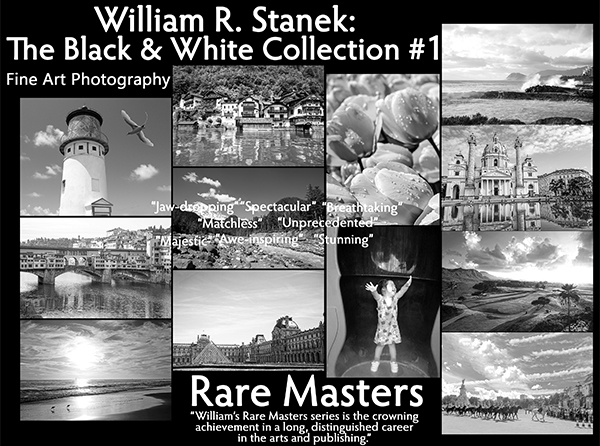
Step into a world of timeless beauty with our premium, oversized hardcover book - crafted for discerning collectors and anyone who values the power of art. Perfect for your coffee table, it's more than just a book; it's a conversation starter, a window into over 30 years of William's visionary photography.
Your Support Matters
Purchasing artwork from William Stanek's collection not only brings beauty into your life but also helps us continue to share. Thank you for supporting our creative journey!

Support The Lights of Paris by Robert Stanek, William Stanek's pen name! Through vivid historical detail and deeply moving character stories, Robert takes readers on an unforgettable journey through one of history’s most transformative times.


